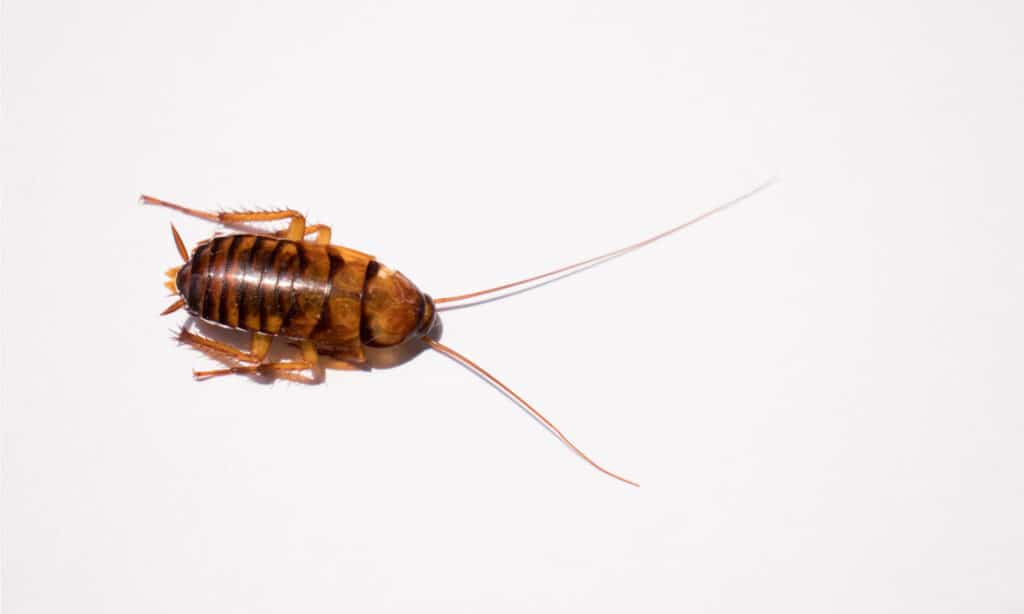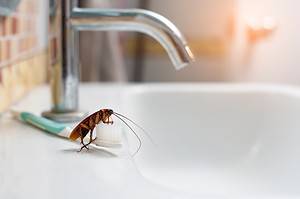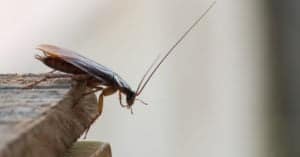Cockroaches are one of the most familiar and widely recognized insects in the world and have been around for a very long time — in fact, they are one of the oldest insect families, dating back to the Carboniferous period over 300 million years ago. In this discussion, we will explore the fascinating world of cockroaches, including their origin and how they got their name. From their seemingly indestructible nature to their role as disease vectors, cockroaches are a fascinating and often misunderstood group of creatures whose origins will be sure to pique your interest. So, let’s dive in!
How Did Cockroaches Get Their Name?

Australian
Cockroach
isolated on white background.
©slothful/Shutterstock.com
While the exact origin of cockroaches is not specific to Spain, the English name for the insect, “cockroach,” is derived from the Spanish word “Cucaracha.” The name “cockroach” actually comes from the Spanish word “Cucaracha,” which was adapted into English in the 17th century. The term “Cucaracha” has been used to refer to various creepy, crawly things since at least the 1600s, and it is believed that the English word for cockroach came about as a result of this Spanish influence.
The Latin name for cockroach is “Blatta,” which means “an insect that shuns the light,” and was used to refer to cockroaches as well as other insects that avoid the light. The name “cockroach” may have arisen from an English mispronunciation of “Cucaracha” or due to folk etymology, where the words “cock” and “roach” were combined to create the name.
What Is The Famous Song “La Cucaracha” About?
“The Song “La Cucaracha” is a popular Spanish-language folk song that originated in Mexico during the Mexican Revolution. The lyrics of the song are satirical and often political and tell the story of a cockroach that cannot walk because it lacks one of its legs. Although the song is not directly related to the insect, the word “cucaracha” has become synonymous with cockroaches over time.”
How Long Have Cockroaches Been Around?

©Naamtoey/Shutterstock.com
it seems that cockroaches originated more than 280 million years ago in the Carboniferous period. However, there is some debate about the exact age of the oldest cockroach fossils, with some estimates putting them at around 125-140 million years old. It’s unclear how they got their name, but the English word “cockroach” may have arisen from a mispronunciation of the Spanish word “Cucaracha,” which was adapted into English in the 17th century.
Overall, cockroaches are a fascinating and resilient group of insects that have been around for a very long time and have adapted to survive in a wide range of environments. Despite their reputation as pests, they play an important role in many ecosystems and have even been studied for their potential medicinal properties.
Are There Any Other Names For Cockroaches In Different Languages?
There are indeed different names for cockroaches in different languages. In Spanish, as mentioned earlier, cockroaches are called “cucarachas.” In German, they are called “Kakerlaken,” in French “cafards,” in Italian “scarafaggi,” in Portuguese “baratas,” and in Russian “тараканы” (tarakany).
The name of the insect can vary depending on the region and the language spoken there. This is not an exhaustive list, and there are likely many other names for cockroaches in other languages and cultures around the world.
What Are Some Cultural Associations With Cockroaches In Different Languages?

©iStock.com/gan chaonan
There are many cultural associations with cockroaches in different languages and cultures around the world. In some cultures, cockroaches are associated with filth and disease, while in others they may be seen as a symbol of resilience or even used in traditional medicine. For example, in China, cockroaches have been used in traditional medicine for centuries, and are believed to have healing properties for a range of ailments.
In some regions of Mexico, certain types of cockroaches are considered a delicacy and are used in regional cuisine. In many other cultures, however, cockroaches are seen as a nuisance and are often associated with poor sanitation. These cultural associations can vary widely depending on factors such as geography, history, religion, and tradition.
Are There Any Idioms Or Expressions Related To Cockroaches In Different Languages?
Yes, there are idioms and expressions related to cockroaches in different languages. For example, in French, the expression “avoir le cafard” (literally “to have the cockroach”) means to be feeling down or depressed.
In Japanese, the term “gokiburi” (ゴキブリ) is a Japanese term for cockroaches. It is often used in Japan to describe a cockroach infestation, an unkempt person, or to refer to the insect itself. The word is derived from “kiburi,” which means pride or arrogance, and “go,” which is a prefix used to indicate respect. The etymology of the term is not entirely clear, but it is believed to have originated in the Meiji era (1868-1912) when Japan began to modernize and Westernize. The term has since become a standard part of the Japanese language and culture.
In addition, there are many other idioms and expressions related to insects or animals in different languages, many of which do not have a direct translation into English. These idioms and expressions are often deeply rooted in the culture and history of the language and can provide insight into the way that people think and communicate in different parts of the world.
The photo featured at the top of this post is © skydie/Shutterstock.com
Thank you for reading! Have some feedback for us? Contact the AZ Animals editorial team.







